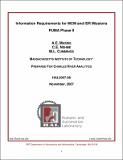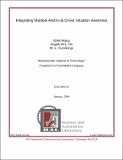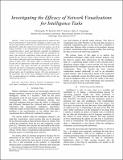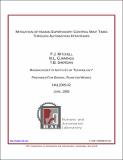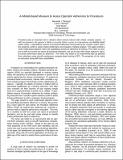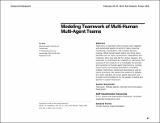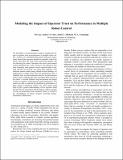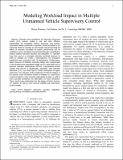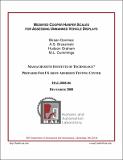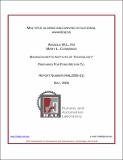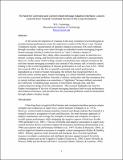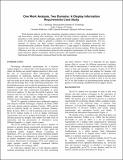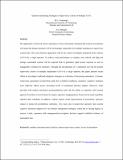Browsing HAL Reports by Title
Now showing items 33-52 of 69
-
The Impact of Multi-layered Data-blocks on Controller Performance
(Air Traffic Control Quarterly, 2008)As a consequence of the push to increase National Airspace System capacity, air traffic control displays will not only have to show the increasing number of aircraft, but also all the associated data such as airspeed and ... -
Information Requirements for MCM and ISR Missions : PUMA Phase II
(MIT Humans and Automation Laboratory, 2007)This document contains display requirements for Littoral Combat Ship (LCS) control station displays to be used by unmanned vehicle units in support of heterogeneous unmanned vehicle missions (such as Special Operations ... -
Integrating Automobile Multiple Intelligent Warning Systems : Performance and Policy Implications
(MIT Humans and Automation Laboratory, 2006)Intelligent driver warning systems can be found in many high-end vehicles on the road today, which will likely rapidly increase as they become standard equipment. However, introducing multiple warning systems into vehicles ... -
Integrating Multiple Alarms & Driver Situation Awareness
(MIT Humans and Automation Laboratory, 2006)This study addresses this gap in CAS and intelligent alarm research by examining whether or not a single master alarm warning versus multiple warnings for the different collision warning systems conveys adequate information ... -
Interface Design for Unmanned Vehicle Supervision through Hybrid Cognitive Task Analysis
(HFES, 2012-10)While there is currently significant interest in developing Unmanned Aerial Systems (UASs) that can be supervised by a single operator, the majority of these systems focus on Intelligence, Surveillance, and Reconnaissance (ISR) ... -
Investigating the Efficacy of Network Visualizations for Intelligence Tasks
(Proceedings of IEEE International Conference on Intelligence and Security Informatics (ISI), 2013-06)There is an increasing requirement for advanced analytical methodologies to help military intelligence analysts cope with the growing amount of data they are saturated with on a daily basis. Specifically, within the context ... -
Mitigation of Human Supervisory Control Wait Times through Automation Strategies
(MIT Humans and Automation Laboratory, 2005)The application of network centric operations principles to human supervisory control (HSC) domains means that humans are increasingly being asked to manage multiple simultaneous HSC processes. However, increases in the ... -
Mixed-Initiative Strategies for Real-time Scheduling of Multiple Unmanned Vehicles
(American Control Conference, 2012)Advances in autonomy have made it possible to invert the typical operator-to-unmanned vehicle ratio so that a single operator can now control multiple heterogeneous Unmanned Vehicles (UVs). Real-time scheduling and task ... -
A Model-Based Measure to Assess Operator Adherence to Procedure
(HFES, 2012-10)Procedures play an important role in domains where humans interact with critical, complex systems. In such environments, the operator’s ability to correctly follow a given set of procedures can directly impact system safety. ... -
Modeling teamwork of multi-human multi-agent teams
(2013-06)Teamwork is important when humans work together with automated agents to perform tasks requiring monitoring, coordination, and complex decision making. While human-agent teams can bring many benefits such as higher ... -
Modeling the Impact of Operator Trust on Performance in Multiple Robot Control,
(AAAI, 2013-03)We developed a system dynamics model to simulate the impact of operator trust on performance in multiple robot control. Analysis of a simulated urban search and rescue experiment showed that operators decided to manually ... -
Modeling Workload Impact in Multiple Unmanned Vehicle Supervisory Control
(IEEE Systems, Man, and Cybernetics, Part A Systems and Humans, 2010)Discrete event simulations for futuristic unmanned vehicle (UV) systems enable a cost and time effective methodology for evaluating various autonomy and human automation design parameters. Operator mental workload is an ... -
Modified Cooper Harper Scales for Assessing Unmanned Vehicle Displays
(MIT Humans and Automation Laboratory, 2008)In unmanned vehicle (UV) operations, displays are often the only information link between operators and vehicles. It is essential these displays present information clearly and efficiently so that operators can interact ... -
Multiple Alarms and Driving Situational Awareness
(MIT Humans and Automation Laboratory, 2005)There is increasing interest in actively mitigating safety in vehicles beyond that of improving crash worthiness. According to the National Highway Transportation Safety Administration (NHTSA), there are more than 40,000 ... -
The Need for Command and Control Instant Message Adaptive Interfaces: Lessons Learned from Tactical Tomahawk Human-in-the-Loop Simulations
(CyberPsychology and Behavior, 2004)In the recent development of a human-in-the-loop simulation test bed designed to examine human performance issues for supervisory control of the Navy’s new Tactical Tomahawk missile, measurements of operator situation ... -
One Work Analysis, Two Domains: A Display Information Requirements Case Study
(HFES, 2012)d observations, among other techniques. Given the time and resources required, we examine how to generalize a work domain analysis technique, namely the hybrid Cognitive Task Analysis (hCTA) method across two domains in ... -
Operator Choice Modeling for UAV Visual Search Tasks
(IEEE Transactions, 2012-09)Unmanned aerial vehicles (UAVs) provide unprecedented access to imagery of possible ground targets of interest in real time. The availability of this imagery is expected to increase with envisaged future missions of one ... -
Operator Objective Function Guidance for a Real-time Unmanned Vehicle Scheduling Algorithm
(AIAA Journal of Aerospace Computing, 2012-12)Advances in autonomy have made it possible to invert the typical operator-to-unmanned-vehicle ratio so that asingle operator can now control multiple heterogeneous unmanned vehicles. Algorithms used in unmanned-vehicle ... -
Operator Performance in Long Duration Control Operations: Switching from Low to High Task Load
(HFES, 2012-10)Long duration, low task load environments are typical for nuclear power plant control rooms, where operators, after hours of operating under a low task load situation, may have to shift to a high task load situation. The ... -
Operator Scheduling Strategies in Supervisory Control of Multiple UAVs
(Aerospace Science and Technology, 2007)The application of network centric operations to time-constrained command and control environments will mean that human operators will be increasingly responsible for multiple simultaneous supervisory control tasks. One ...


